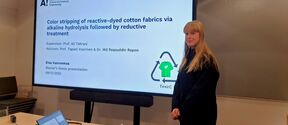Aalto Materials Digitalization Platform - AMAD
Materials data infrastructure for Aalto University
The Aalto Materials Digitalisation Platform (AMAD) is a modular, digital research platform for materials data. It provides digital tools, such as electronic notebooks, data management, procedure tracking, post-processing, simulation tools, automation software, and the dissemination of results. And because AMAD is web-based, it facilitates collaboration across campus or around the world.
AMAD’s purpose is to connect different stakeholders to advance materials design and development so that academia, industry, government, and society can benefit from Open Science. AMAD facilitates the collection, documentation, management, analysis, sharing and reusing of data in line with the FAIR (Findable, Accessible, Interoperable, and Reusable) principles, which publicly supported research organizations and funding bodies require. It also enables the use of digital research tools, machine learning, and automation.
According to the researchers we spoke with, AMAD simplifies data sharing and collaboration. In addition, AMAD helps users to apply machine learning in a simple way to support experimental research and analysis.
‘Interdisciplinary projects need a good way to exchange data,’ Joakim says. ‘AMAD offers an excellent way to do this. It lets you do everything in electronic format, allows you to access the data and download it, if needed.’
In one project using AMAD, experimental data is stored in AMAD and artificial intelligence is then used to guide further experiments. The workflow starts with the researcher in the lab, who uploads data to AMAD. Their collaborators then apply machine learning to the data to determine what experiments to best perform next. The workflow continues iteratively until the experiment is completed, for example, a material has been optimized or fully characterised. All data collected in the process is stored on AMAD and available for further analysis.
‘AMAD helps us bridge the gap between AI experts, who may have limited materials science knowledge, and materials experts, who may have limited AI knowledge, in an efficient way,’ Matthias says. ‘Without AMAD our experiments would have taken a lot more time and a lot more errors would have been made. For example, the machine learning algorithm we used automatically inserted relevant information for the experimentalists in AMAD. If this process had happened by hand, it would have been way more likely that at some point typos would have been made.’
In the research project that Juha works in, two algorithms, Bayesian Optimisation and Large-scale Atomic/Molecular Massively Parallel Simulator (LAMMPS), communicate through AMAD.
AMAD was chosen because of its easy-to-use interface. AMAD stores and displays information in tables, and it is then easy for automated algorithms to access this information. The LAMMPS algorithm, for example, reads data from AMAD, performs a calculation and returns its output to AMAD. The Bayesian Optimisation algorithm receives notice that LAMMPS entered data, reads this data, performs its next optimization step and enters new information for LAMMPS in the AMAD tables.
‘Our aim is to make complex algorithms accessible and user-friendly,’ Juha explains. ‘I believe that anyone, regardless of their technical background, should have access to advanced algorithms and tools, like the ones we are developing. AMAD lets researchers choose how much and what kinds of data to share, and with whom, at any stage in the research process.’
‘AMAD makes my work a lot easier,’ Joakim says. ‘It replaces the need for traditional lab notebooks, allowing us to store all necessary information in one easily accessible place. AMAD has enabled us to achieve new possibilities that would have been difficult without it.’
Joakim is sure that without AMAD the research team would forget things. Both Joakim and Matteo say that AMAD can replace a paper lab notebook, keeping information on what was done in one place. An additional advantage is that the research results stay in the research network even when researchers leave or move to a different location. ‘AMAD not only provides the tools for sharing information, but also acts as a notebook for yourself,’ Matteo states. ‘In addition to sharing with others, you can use it as a diary of your experiments.’
Matthias also recommends using AMAD as a digital lab notebook. ‘AMAD makes communication within a group so much easier, and people working with machine learning can benefit from it. It's a nice, centralised way to understand your data and work with it,’ Matthias explains.
‘AMAD is also available for external researchers collaborating with Aalto,’ Matthias says. ‘I warmly encourage Aalto researchers to take advantage of the AMAD platform's digitalisation potential for data sharing and collaboration in research.’
Joakim advocates trying out AMAD. ‘I would like to see Aalto researchers test AMAD, if not themselves, then through their students. To take advantage of its useful features for more efficient and streamlined research.’
AMAD is provided by Aalto IT Services. All Aalto researchers can access AMAD by logging in to https://amad.aalto.fi/ with their Aalto account. In addition, collaborators of Aalto researchers from external organizations can request an account.
More information about AMAD can be found on AMAD’s service page and in the user guide.
In case you need support or have any questions on AMAD, please contact amad@aalto.fi.

Materials data infrastructure for Aalto University



